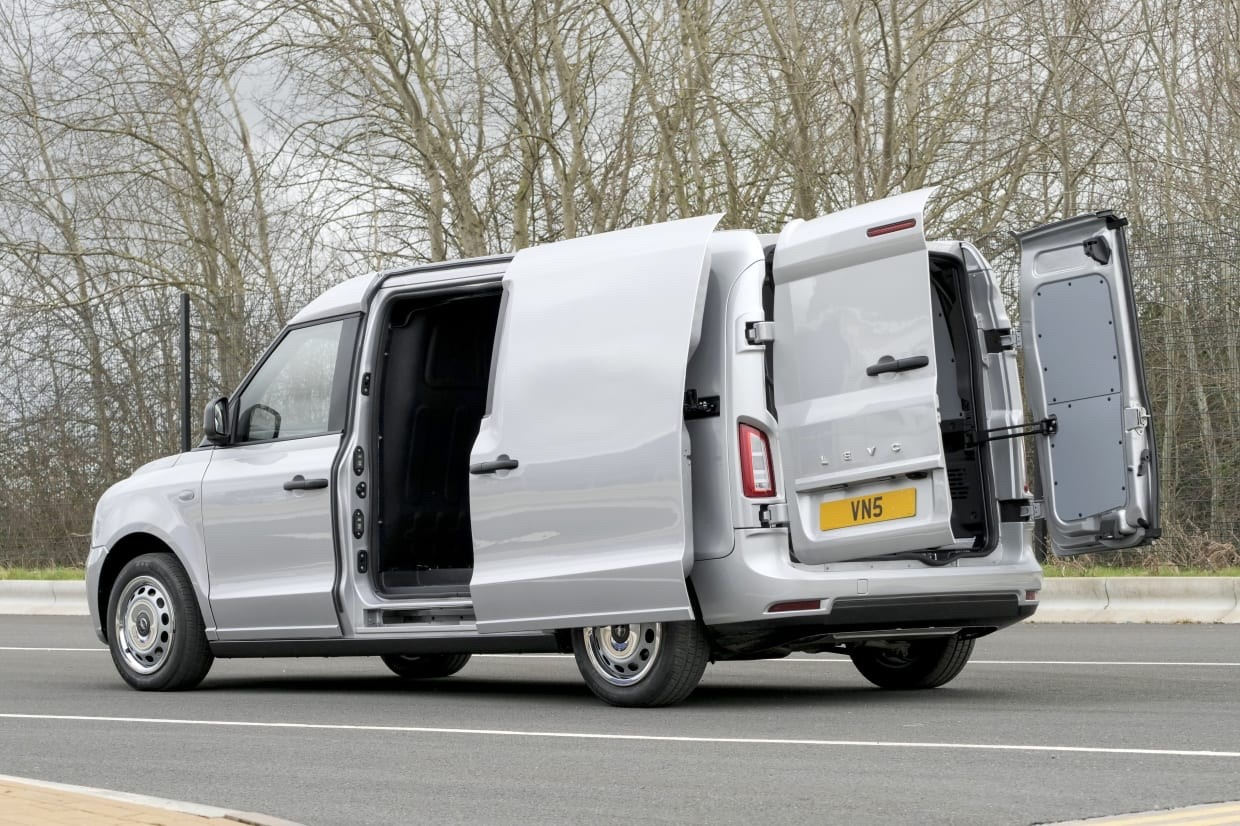
A little indulgence for me this week, I confess, in the semi-familiar shape of the London Electric Vehicle Company (LEVC) VN5 van. Because I’m an overgrown schoolboy and want to drive everything, vans and taxis included, when I was presented with an opportunity to drive a van and taxi both at once, so to speak, I gladly seized it. To me, the VN5 is the okapi of the car world, rarely glimpsed and so curious because it looks like a missing link. Irresistible. So, as you will notice, the front half looks very much like a taxi cab, while the back is a large, practical van-style boxy structure, given over to cargo (5.5 cubic metres and 830 kg to be precise). It’s of course derived from the LEVC TX taxis we see running around our cities, with an aluminium “chassis” and some composite bodywork on top, and it doesn’t look too bad. Indeed it’s rather distinctive, which might recommend it to some customers, smaller retailers, say, looking for a more eye-catching form of mobile advertising.
It’s also an early example of a wave of electric vans coming our way, as I saw for myself at the recent Commerical Vehicle Show in Birmingham. Ford’s overdue all-electric Transit arrives at last next year, while Vauxhall and its sister brands Peugeot and Citroen, as well as Renault, are established leaders in the field. Other impressive entrants are Maxus, owned by SAIC of China, and a smaller new import operation, Innovation Automotive, bringing in light commercial products from Dongfeng (badged as DFSK), among others. Indeed LEVC, via a circuitous route involving British Leyland and management buy-outs, is now controlled by the giant Geely of China.
THE SPEC
LEVC VN5
Price: £52,000 (ex VAT; range starts at £46,500)
Motor: Electric via 31kWh battery pack and 1.5l petrol range extender
Power: 110kw
Top speed: 80mph
0-60: 13.2 seconds
Fuel economy: 313.9 mpg (equiv)
CO2 emissions: 21.2 g/km
So this is all good news, because our streets will be that little bit quieter and our air a good deal less polluted as our old diesel vans are supplanted by these fresh modern electric designs. The VN5 is particularly interesting because of the way it operates as a “hybrid”. Usually these types of vehicle, the Toyota Prius being the most ubiquitous, use batteries and an electric motor working together in support of or in tandem with a conventional petrol engine. In the VN5, like its TX sibling, there is a large (31kWh) battery pack allied to an electric motor that will deliver about 60 miles of typical urban collection/delivery use. There is also a small three-cylinder petrol engine on board, but that doesn’t drive the wheels directly. Rather, it acts as a generator, topping up the battery pack as needed, and adding another 250 miles or so to the range, giving the flexibility for longer journeys. Thus the power from the petrol tank is converted first into mechanical power and then into electrical power.

Obviously you can, and should, plug your VN5 in to the mains electricity to make the most of cheaper refuelling, which is done quickly (half an hour on a fast charger), and the VN5 can be “filled up” from any kind of electric charge point. It’s a design that was used some years ago on the pioneering GM Chevrolet Volt and Vauxhall Ampera, but is now uncommon. The VN5 is really best thought of as a van with the emphasis very much on the electric side of the equation, and works well if used that way, with the internal combustion engine element used more sparingly.

As you’d expect, it’s good to drive and use. You sit quite high for a medium van, and the cab is thoughtfully laid out. The portrait-format touchscreen, switches and minor controls are Volvo-sourced, Volvo now being another associate of Geely (along with Lotus, as it happens), and Volvo also provides the range-extender petrol generator. The big back doors flatten back as they open and there’s a wide side door too, and you can almost stand up in the boxy interior. The tight taxi-style turning circle is another boon. The plastic bodywork should stand up better to knocks and bumps, too, compared with its sheet-steel rivals. I found the sliding door a bit tricky because the central locking system needs it to have a good slam to recognise the fact that it is in fact safely shut. Distinctive, driver-friendly and built in Britain, there’s much to like in the VN5, and I’m quite excited to see there’s a camper van version on the way.
As ever, the drawback for businesses is the same as it is for consumers with such vehicles, though with businesses the calculations are even more acute: weighing the high up-front purchase costs against the low running expenses over a realistic life of the van. Traditionally vans have had shorter lifespans than cars because they lead arduous lives, but the arrival of these new highly efficient and durable designs may alter those assumptions, provided the likes of the VN5 stand up to the abuse they’ll get. I drove my VN5 as hard as I could, and threw whatever I could in the back, and it acquitted itself well. The LEVC VN5 is the only vehicle now being made in Coventry, once such a hub of the motor industry. I hope it succeeds, as a still-small player in the light commercial vehicle sector; it deserves to.







